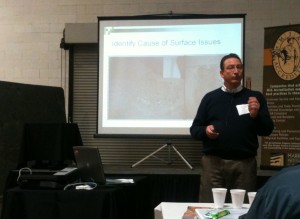Moraware is a sponsor of the Marble Institute of America seminar series for 2011, so we can help countertop fabricators run their businesses better. I covered the first part of the seminar here.
After the introduction to stone selection and uses from Danny MacNair, Mike Micalizzi of Custom Building Products presented some of the standards and best practices in preparing floors, walls, cabinets and other surfaces for a slab or stone tile installation.
The basic principle for preparing a surface for stone installation boils down to 3 things. A surface must be Sound, True, and Ready.
- Sound & Rigid: A surface needs to support the weight of a stone installation, and also deflection and vibration. The surface should resist curvature, ideally no more curvature than 1/2″ every 30 feet.
- Smooth & True: Horizontal surfaces like floors and countertops should be level – preferably no more slant than 1/4″ over 10 feet. Walls shouldn’t lean by more than 1/8″ per 10 feet. Variations (or bumps) in the surface shouldn’t be more than 1/16″ per foot. The surfaces should have some profile – for floors and walls, it should be like the ICRI standard 2 or 3.
- Ready to Accept Bond:Everything should be clean, dry, and free from grease, oil, dirt, sealers, adhesives, etc. Concrete surfaces should be cured and should accept water so there’s no loss of adhesion.
Mike went into much more detail about each of these three, and also discussed some of the things he’d seen on job sites as well as the best practices that he and his company recommend. Even though most of the best practices sound like common sense (don’t apply glue over dusty surfaces, for example) it seems like they’re not followed very often.
Finally, Rod Sigman (also from CBP) talked about the role of sealing and cleaning natural stone. From Rod’s perspective, the critical thing about sealers is setting the expectation about what sealing natural stone will and won’t do. According to Rod, sealers will:
- Provide a degree of stain resistance
- Provide a degree of water repellent
- Reduce ongoing maintenance
- Minimize severity of etching
You’ll notice that none of the terms are absolutes – the most common misconceptions arise from the fact that sealers don’t make stone maintenance-free or stain proof. When you are doing routine maintenance, it’s important to use pH-neutral cleaners that won’t break down the sealers. Rod showed a really terrible example of what can happen when you combine the wrong expectations and cleaner.
On a high-end cruise ship with lots of white marble, the cleaning crew assumed that because it was sealed, the marble wouldn’t absorb any stains. They used a pink disinfectant on many of the surfaces, resulting in a bright pink stone throughout the ship. A cross-section revealed that the pink had stained almost all of the way through the stone.
Want to know more? At Moraware, we make software for countertop fabricators. JobTracker is scheduling software that helps you eliminate the time you waste looking for job folders. RemnantSwap is a place to buy and sell granite remnants with fabricators near you.

